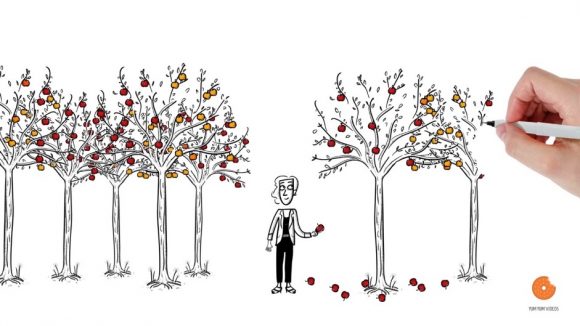5 Tips to Make a Whiteboard Animation Video Like a Pro

What happens when you’ve got a lot of information – about products or business, whether yours or your client’s – that you want your audience to understand effectively?
You could try the written route and write long posts going over the details one by one. Maybe, you could jump on Instagram and make a 45-minute-long marketing live stream going into each point you wish to cover…
The problem is that people live through the internet nowadays, and short attention spans present a formidable obstacle! Even the most excited and loyal core audience would get discouraged by approaches like those.
The good news is that video gives you the perfect platform to deliver a lot of information in a short amount of time, doing so in compelling and engaging ways. And among all the types of marketing videos out there, none work better in this regard than whiteboard animated videos.
What is a Whiteboard Animation Video?
Even if you hadn’t known they were called that before now, the chances are that you have seen whiteboard animations already! These are videos that simulate something being drawn on a white background by an artist right in front of your eyes. They paint a story in real-time, using seemingly drawn lines that come alive with dynamic animations.
The style combines the appeal of cartoon animation with the simple and familiar benefits of a whiteboard explanation – making them a fantastic tool to educate an audience on topics that would be too complex or take too long to cover otherwise.
However, great as they are, doing a compelling whiteboard video can be tricky! Especially if you aren’t familiar with the ins-and-outs of the format. So, let’s go over some of the basics of pre-production for whiteboard videos that can help you create tailored pieces that will capture your audiences’ minds.
Start With a Solid Script
Every good marketing video starts with an engaging script. It is the soul and backbone of your video. Scripts are what give you a structure to work with and define what will drive your audience’s interest: Your message.
So, how do you go about creating a functional structure?
For whiteboard videos, you need to start by presenting your character and their story. These should mimic the buyer persona you are trying to connect with, and their situation (more on this later.) Then evolve the story naturally for you to propose a solution to the issues you have put forth. Explain that solution in as simple a way possible, and wrap it all up with triggers to prompt action from viewers.
Let’s review that step-by-step here:
- Present the situation: Your main character and the problem that they have.
- Introduce a solution: The product or service that you’re presenting.
- Explain how this solution works: Time to make your value proposition shine!
- Finish with a CTA: Prompt your audience to take action.
Also important: make sure that you communicate your core message from the start! People’s attention spans are getting shorter every day (not to mention they are constantly blasted by notifications and alerts from all sides,) so it is unlikely that all of them will stick until the end of your video.
Spend some time polishing the beginning of your script, make it engaging, and spend the rest of your wordcount building upon that.
Create A Character That Mirrors Your Target Audience
There’s a certain magic that happens when you manage to create a character that accurately reflects the audience you are trying to attract. It instantly makes your video appealing, engaging, and more importantly, relatable – Making it easy for your audience to stick around and digest the information.
Done right, you’ll have viewers instantly connecting with your content, with the story you are putting in front of them, on a conscious and unconscious level.
You can accomplish this by modeling your video’s characters after them! Using your buyer personas as a framework.
What’s a buyer persona?
It’s the answer to the question, “Who are you targeting with your content?”
A buyer persona is made by defining the common traits and characteristics of who you would consider an ideal audience member and accounting for demographic differences. Conceptually, you can give these personas a name, age, occupation… pinpoint their needs and even imagine their hobbies!
For example, using your knowledge about your audience, you might define that the average person looking at videos on your blog is Linda, a middle-aged woman who loves cats and has a secret obsession with Harry Potter fanfiction.

What are Linda’s problems? Maybe she needs reliable DIY home improvement advice! How do you provide a solution for her? Maybe you have a section on your blog with a library of DIY guides that fall right on her bailiwick.
If you want to engage Linda, you will tailor your content to cater to her needs, and moreover, you’d do well to tailor your videos’ character after her. This will help you create accurate, valuable content that will appeal to Linda, and people like her.
Using this method, you can quickly have your whiteboard videos’ characters come alive, and have your audience feel represented, making it easier for them to connect with your story and your brand’s message.
Use Visuals That Make Your Message Come Alive
Once you have taken care of those elements, it’s time to start defining your piece in visual terms. And for that, you’ll need a storyboard!
Storyboards allow you to define and describe the primary visual cues and actions that will compose your piece.
As crucial as reflecting your audience with your characters and creating a well-structured, exciting script are, your storyboard is probably the lynchpin of the whole video production process. All that comes after it (illustrations, animation, voice-over, etc.) will refer back to your storyboard as a guide.
Here’s what a typical whiteboard video storyboard looks like:

Each snapshot gives you a clear idea of the main graphics that will make up each scene. Each one is accompanied by a clear but brief description of camera movement and animations, which help you flesh out and nail down the details of your video. Lastly, you can see which piece of your script (now, the voice-over) will play along with each scene.
Lastly, notice how the main visual cues occur in seamless succession; this is a trademark of the whiteboard style, creating the illusion of a continuous drawing, meaning that individual scenes won’t be swapping out as it appears in other types of videos.
Make sure all these elements are present, and you’ll have a robust and useful storyboard in your hands.
Implement Effective Branding Strategies
A well-made whiteboard video can quickly become the centerpiece of a marketing push, garnering a lot of buzz and attention from your audience. As such, it’s important you don’t miss an incredible opportunity by not branding your video accordingly!
Using black-lined drawing on a white background is a staple of the whiteboard style, but that doesn’t mean you can’t use color anywhere, all the contrary! Having a straightforward black and white setup makes it that much more impactful and effective whenever color does makes an appearance.
Using your brand’s logo colors can make for the perfect setup to the introduction of your proposed solution, creating a connection between solving a problem and your brand. Jingles and sounds can act in much the same way, driving the viewer’s attention where you need it most.
Your brand’s name and actual logo should also appear at critical stages of your video, most importantly at the end alongside your CTAs at the end. When done right, this will give your content permanence in your audience’s minds, and make sure your brand stays with them long after they watch your content.
The Devil Is in The Details!
You might feel drawn to try and differentiate your whiteboard video from all others by breaking apart from the style’s conventions. While I can’t tell you never to do it, I will tell you that you should first know the rules to break them effectively.
Whiteboard videos’ effectiveness is the result of all their component parts interplaying with each other. As such, changing some or outright removing them might severely impact how well your video performs.
So, before you leave, I wanted to go over a handful aspects common to these videos I’d strongly advise you to reconsider if you decide to change anything.
Length is critical in all marketing pieces, and shorter videos usually outperform longer versions. Try and keep your whiteboard animations under the 90-second mark.
White backgrounds, black drawings, and the hand are non-negotiable! These are the soul-components of the style and have become staples for a reason. You can hardly create a whiteboard video without them.

Lastly, there’s the issue of quality. You need to keep in mind that online, audiences take your content as a reflection of your business’ capabilities, which means that you don’t want to cut corners in terms of visual quality and animations.
A good idea is to go through the portfolios of recognized whiteboard animation companies to draw inspiration and production cues.
Wrapping Up
There are plenty of ways you can use video content on your blog to increase engagement, and whiteboard videos are perfect fits when you need to deliver a lot of information while keeping viewers interested at the same time.
There are a lot of balls you’ll need to juggle to make a whiteboard video like a pro, but I hope the tips we’ve discussed here today will make the whole project much more manageable for you!
And if it feels like it’s getting to be “too much,” just focus on making all the pre-production tasks as best developed as you possibly can. You can always bring someone in later to help you with animations and that sort of stuff if you have a fun and interesting script, and have modeled your character appropriately after your audience.
Now it’s up to you! Are you ready to unleash the power of this kind of animation? Then get that thinking cap on and start dreaming up your next whiteboard video!

